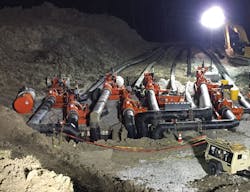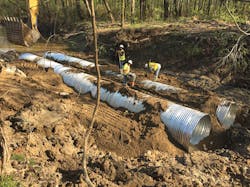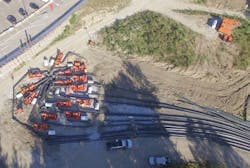By Ken Albaugh
For a solid month in 2016, it seemed like the rain never stopped in Memphis, Tenn. The city’s wettest March on record poured more than 16 inches of rain on residents, with half of that coming during a two-day deluge March 9-10. This overwhelming influx of water eroded the soil supporting a 96-inch sanitary sewer main that crosses South Cypress Creek and carries wastewater to the T.E. Maxson Wastewater Treatment Plant. After holding out for a full month, the line gave way on March 31. City officials immediately activated their Emergency Response Plan, gathering the management team from the Public Works Division and bringing in the experts at Xylem to help assess the damage and to map out an action plan.
No Time to Waste
It was determined that an emergency bypass was needed to circumvent the 96-inch sewer main. As part of the Emergency Response Plan, Xylem was named general contractor for the bypass project and charged with providing a turnkey solution.
With no time to waste and lots of hard work to be done, Xylem quickly organized and coordinated around-the-clock job teams. More than 30 Xylem staff members managed and worked side-by-side with approximately 100 Memphis Public Works and 60 contractor personnel to complete all necessary tasks. This all-hands-on-deck approach greatly accelerated the project timeline. Bypass solutions of this magnitude typically take upwards of two to three weeks to implement. The Xylem-led teams were able to get them done in a fraction of that time.
The bypass needed to handle 160 million gallons per day (MGD) of flow and traverse approximately 2,400 linear feet from the suction point to the discharge location. To help execute the monumental effort in an extremely compressed timeframe, the Xylem team mobilized the necessary equipment and accessories and had everything onsite within 30 hours.
“Xylem was able to marshal the equipment, the pumps and whatever else was needed and get the job done,” said Paul Patterson, environmental engineering administrator for the City of Memphis. “They had the resources, number one, and they had people that understood and knew how to utilize those resources. Public Works had the manpower, we had good employees that were willing to work, and we had equipment as well. So all of that put together resulted in a very successful response.”
Before any water could be pumped, there were several “critical path” projects that had to be executed, from creating a right-of-way for the bypass to shoring up 250 feet of embankment on one side of the suction pit where the pumps would be positioned (see sidebar).
The Heart of the Bypass
To handle the 160 MGD of peak flow, Xylem mobilized 14 Godwin diesel-driven Dri-Prime CD400M pumps. Each pump would be pushing approximately 11.5 MGD of flow through 24-inch HDPE suction tubes and 18-inch discharge tubes into an eight-foot square concrete manhole structure. Six days after the break, five of the 14 Godwin pumps were operational and handling 50 MGD of flow - a typical average daily flow rate for the system.
To cover the 2,400 feet of travel distance, the bypass utilized 30,000 feet of piping that Xylem shipped in from its rental locations up and down the east coast. A dozen factory-trained and certified Xylem fusion techs, from as far away as California, operated fusion machines in four different staging areas. Working non-stop for a week, the teams fused together 50-foot pieces of pipe into 500-foot sections that were then moved into place along the right-of-way.
As the piping was set, the other nine pumps were installed and all 14 pumps put in place just two weeks after the break. One additional CD400M pump was also on site and ready to go as a redundant backup.
In addition to the primary bypass, Xylem installed a separate 36-inch bypass line to handle 11 MGD of flow and ensure minimal impact on the structure. This bypass utilized two Godwin hydraulically driven CD300M pumps and a backup pump - all run by diesel power packs located 100 feet away behind a berm for flood protection and to prevent environmental contamination. The discharge piping consisted of two 18-inch HDPE pipes that ran for 2,400 feet to the same discharge structure as the primary bypass.
Once the pumps were online, Xylem switched over to 24/7 bypass operating mode. Two teams of on-site Xylem mechanics worked alternating 12-hour shifts to operate, monitor, service and repair the pumps and turn them on and off as flow fluctuated. The bypass system worked exactly as planned, pumping approximately 60 to 160 MGD of raw sewage.
“The project as a whole was amazing,” said Mike Leonard, branch manager for Xylem. “Everybody worked together, working 16- and 18-hour shifts. We had people bringing us food and water, keeping the crews moving so they didn’t have to leave the site. It was just a total job put together, from the city to the contractors to Xylem, that just worked as a whole. Everyone jumped right in to help - to help Memphis.”
Teamwork and Collaboration
Xylem delivered a comprehensive turnkey bypass solution to the City of Memphis, overcoming numerous obstacles to get it done safely and cost-effectively in a remarkably short period of time. Working around the clock and utilizing more than 20 pieces of heavy equipment and machinery, the Xylem-led team mobilized and installed 18 pumps, nearly six miles of 18-inch and 24-inch HDPE pipe and all corresponding accessories necessary for the bypass - all in just two weeks.
“One of the benefits of having the turnkey solution on a project such as this,” continued Patterson, “is it allowed the city to focus on the design and the construction (of the replacement line) once the bypass had been established. Xylem was going to design, implement, and maintain the bypass, so we were able to focus our resources and our efforts entirely on design and construction and getting the pipe replaced. And that was key.”
About the Author: Ken Albaugh is the central regional director for Xylem. He can be reached at [email protected].
Supporting the Bypass
Before any water could be pumped, there were several “critical path” projects that had to be executed.
Excavation/Creation of Roadway
Utilizing more than a dozen excavators and bulldozers, a 2,400-foot-long, 40-foot-wide road was created to establish a path for the bypass. In excess of 6,500 yards of recycled material was hauled in as a base for the right-of-way.
Excavation/Creation of Suction Pit
A suction pit - 150 feet wide on each side and 40 feet deep - was created to situate the pumps. The base of the pit was built using 40,000 cubic yards of imported material.
Excavation/Installation of Culvert
As a critical piece of the bypass right-of-way, two 86-inch culverts side-by-side, each 100 feet long, were installed to contain the bypass piping as it crossed Cypress Creek.
Erosion Control
Xylem brought in a shoring contractor to minimize erosion along the suction pit. The contractor drilled pilings 70 feet deep to address 250 linear feet of shoring, and installed erosion control material along the 2,400 foot right-of-way.
Re-route Battery Supply Line
The 13-kilovolt (kV) battery supply line for a substation adjacent to the bypass right-of-way was moved to provide adequate clearance from bypass operations.
Plugging: Line 1
Plugs were installed at the suction and discharge ends of the main. To reduce dependency on the plugs, city officials asked Xylem to design a redundant plugging option. A customized steel plate was designed and placed over the ends of the existing pipes.
Plugging: Line 2
While work was done on the 96-inch main, an abandoned 60-inch sewer line needed to be re-plugged. An inflatable plug was installed at the manhole downstream from the suction structure, and the abandoned 60-inch line was filled with concrete to ensure the line was completely sealed from the 96-inch main.








